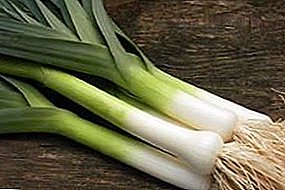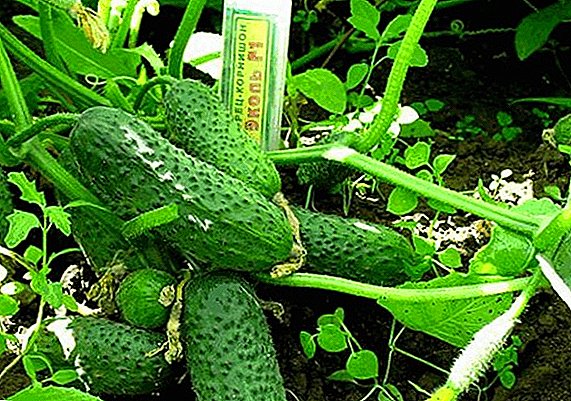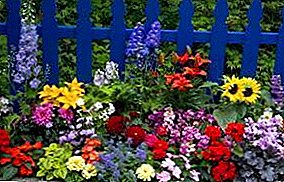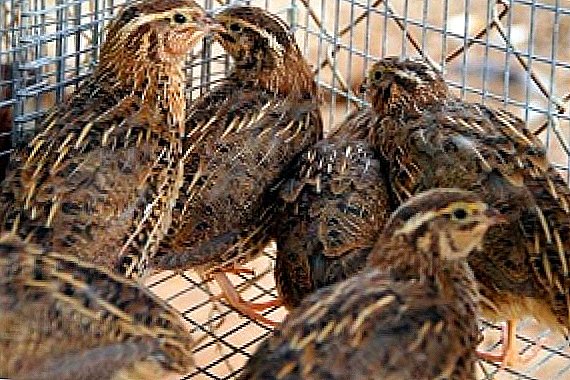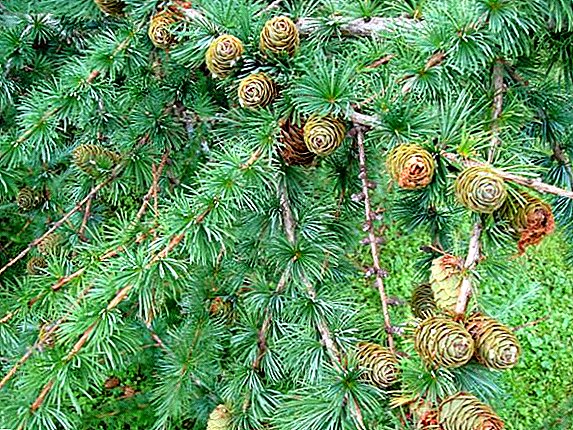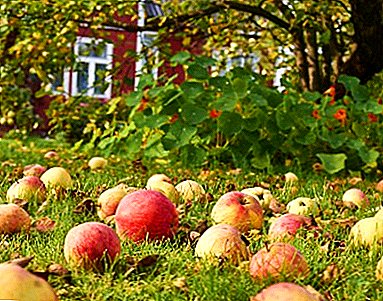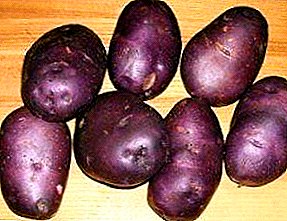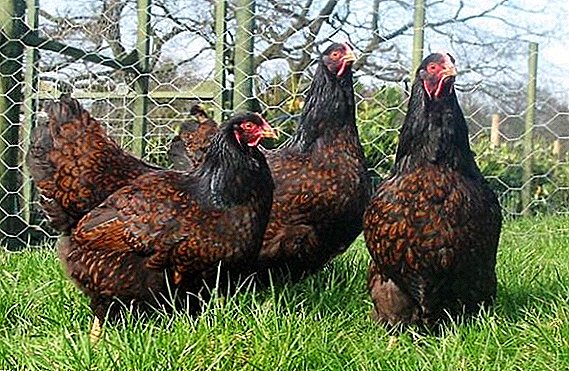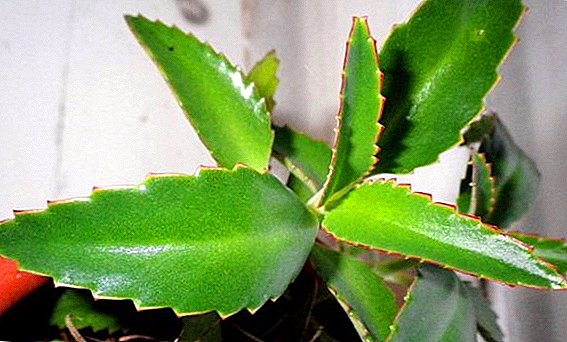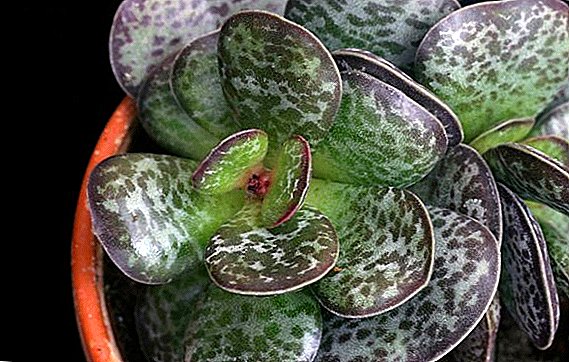 In home gardening, plants that bloom beautifully, with an exotic look, and those that require little time and effort from the owner, are popular.
In home gardening, plants that bloom beautifully, with an exotic look, and those that require little time and effort from the owner, are popular.
The latter includes adromiscus, one of the representatives of the Tolstyankov family.
Botanical description of the plant
Adromiscus is a perennial, growing in the form of a grassy plant or a small shrub. His homeland - the south-western and southern areas of Africa. In room culture, it grows no higher than 15 cm. It has a short and thick creeping stem, on which reddish aerial roots are formed. The leaves, like most fatty, fleshy and juicy. They can be smooth or hairy, with a variegated color. Triangular or rounded in shape.
In the period of flowering on the plant appear long stalks with inflorescence in the form of an ear with five-petal flowers of white or pink color. However, at home flowering is very rare.  The name of the plant was due to its botanical features - the Greek word Adromischus consists of 2 words: adros (fat) and mischos (stem).
The name of the plant was due to its botanical features - the Greek word Adromischus consists of 2 words: adros (fat) and mischos (stem).
Did you know? As recorded in the pages of the Guinness Book of Records, the largest and most smelly flower in the world is amorphofallus or a corpse flower. Its smell is reminiscent of the stench of rotten fish and eggs. However, the Japanese use its tubers to make soups and stews.
Main types
The genus adromiscus unites about 50 species. In room culture the most common are:
- Comb The stem of this species grows up to 10 cm. The leaves are in the form of small triangles. Their edges are wavy, in appearance resemble ridges. Reddish aerial roots are formed on the stem. Blooms adromiscus comb small flowers, collected in a tube, white-green with pink border.
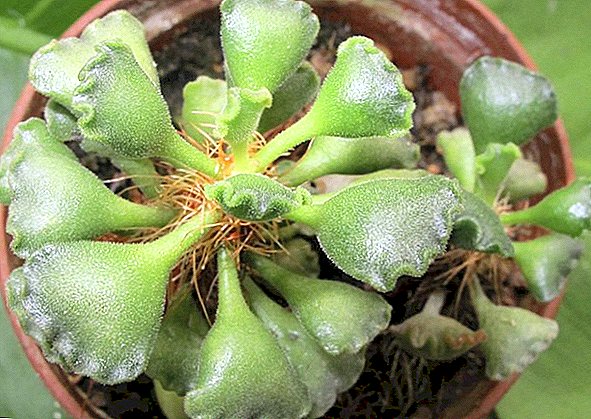
- Cooper. This variety is easily recognizable by the original color of the leaves - they are covered with dark brown specks. Their shape is wavy, the surface is smooth. Flowers are greenish red with pink or purple edging, 2-5 cm in diameter.
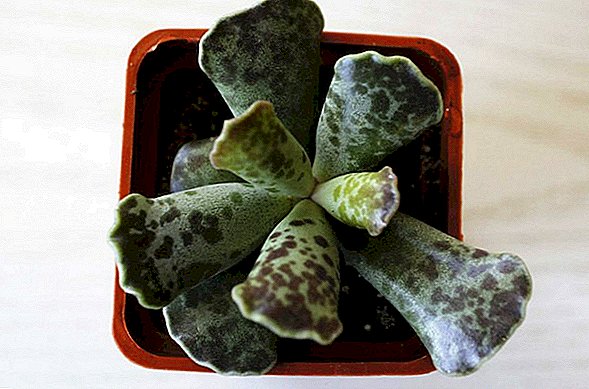
- Pelnitz The stem reaches a maximum height of 10 cm. The shoots are light green, narrow at the base and widened to the top. The ends of them are wavy and fleecy. The length of the peduncle and inflorescence is about 40 cm.
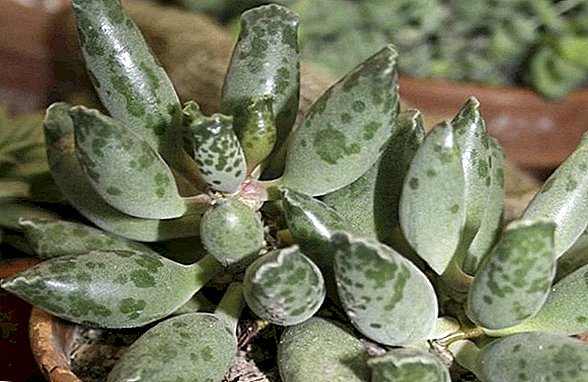
- Spotted. Compact weakly branching view. The leaves are light green with reddish specks. They are oval or rounded in shape. The flowers of adromiscus spotted are collected in a tubular spikelet, painted red and brown.
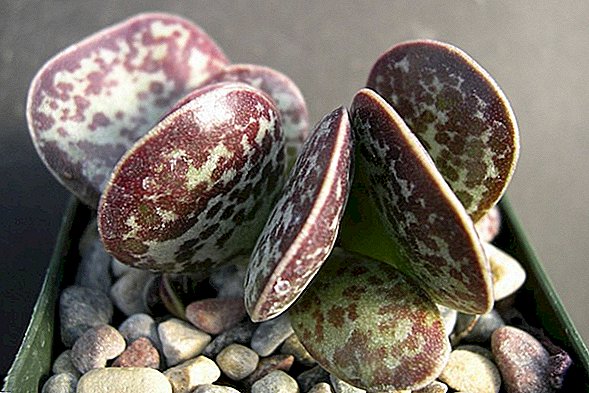
- Three-pedal. It is characterized by compactness and weak branching. The leaves reach a length of 5 cm. Their shape is rounded, slightly elongated. The color is dark green with red-brown specks all over the leaf plate. A three-peacock variety blooms with reddish flowers.
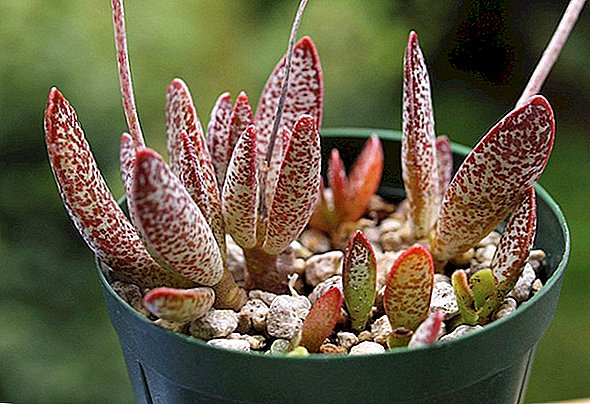
- Mariana The original look with large texture sheets of reddish color. Differs in slow growth and increased light-loving.
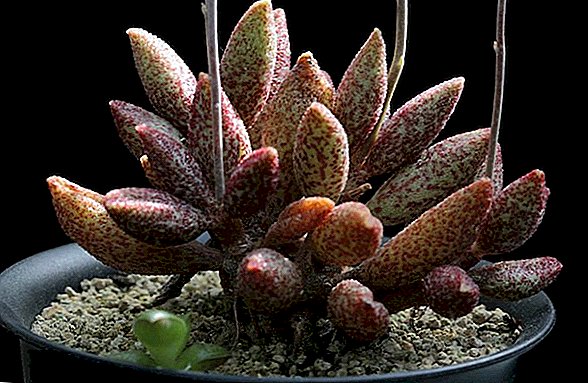
Required microclimate
Since adromiscus is a native of the hot African continent, among its preferences is bright light and heat. The highest decoration can be achieved only by providing these 2 conditions.
Did you know? Wolfia spherical is recognized as the smallest flowering plant on Earth. It reaches a diameter of 100–200 µm and a weight of 150 µg.
Location
The pot with adromiscus should be put in the most lighted place in the apartment. The brighter the light, the more intense the coloring of the leaves. This representative of craving is not even afraid of the sun's rays falling at a right angle. When grown on the north side will require additional lighting.  Another condition for normal growth and development is the absence of drafts. At the same time the flower loves fresh air. Therefore, when airing, it is necessary to ensure that the plant does not fall under cold air currents.
Another condition for normal growth and development is the absence of drafts. At the same time the flower loves fresh air. Therefore, when airing, it is necessary to ensure that the plant does not fall under cold air currents.
Temperature conditions
In the summer, this indoor culture feels great at + 25 ... + 30 ° С. In winter, she needs to create cool conditions for a rest period. The optimum temperature for adromiscus content at this time of the year is from + 10 ° С to + 15 ° С. Lowering the thermometer below + 7 ° C is considered critical. Low temperatures have a negative effect on the growth and development of the flower.
Check out the most popular home-made succulent plants.
Air humidity
Adromiscus is indifferent to the humidity parameters in the room. It will grow normally with any indicators in the apartment. Does not need spraying.
Home care
Adromiscus requires standard care procedures: watering, feeding, transplants. The health of the plant depends on how regularly and efficiently they are carried out.
Watering
Adromiscus roots are gentle and sensitive to stagnant moisture. Therefore, excessively moisturize the plant can not, it can lead to his death. There is an unspoken rule among experienced owners of sweeping leaves - it is better to over-hold a flower without water a little, than to fill it. It is tolerant to droughts. Moistening is necessary to produce only after complete drying of the upper soil layer. In spring and summer, it should be moderate, not more than 1 time in 1-1.5 weeks. In the fall, the frequency of watering should be gradually reduced to 1 time per month, and in winter to stop them altogether.
It is tolerant to droughts. Moistening is necessary to produce only after complete drying of the upper soil layer. In spring and summer, it should be moderate, not more than 1 time in 1-1.5 weeks. In the fall, the frequency of watering should be gradually reduced to 1 time per month, and in winter to stop them altogether.
For irrigation take tap water, separated for 1-2 days. Moistening with cold and hard water is prohibited.
Adromiscus is poured over 2 ways: the traditional top and bottom in the pan. When the upper irrigation water should be poured strictly at the root, avoiding droplets on the leaves and the stem. With lower watering, you can not worry about the fact that the plant will be over-humidified, as it itself will pick up as much moisture as it needs at the moment. The main thing - do not forget to drain unused water from the pan after 20-30 minutes. For a long time it should not stand.
Top dressing
It is necessary to feed the indoor culture from March to September. The recommended frequency of fertilizer application is 1 time per month. For dressings use store tools developed for cacti and succulents. The solution is prepared in accordance with the instructions for use. Bring it only in a well-moistened ground to prevent burns of the roots.  From October to February, i.e. during the period of rest, it is prohibited to fertilize the flower.
From October to February, i.e. during the period of rest, it is prohibited to fertilize the flower.
Transfer
Adromiscus is transplanted as needed when it becomes crowded in a pot. The transplant process is planned for early spring. Before planting, it is necessary to prepare in advance the necessary soil and a pot that is larger in diameter and height.
The soil can be purchased at a specialty store. The one on the package that says "For cacti and succulents" will do. In it you can mix some sand. You can also cook it yourself. To do this, mix garden soil (2 parts), leaf humus (2 parts), coarse sand (3 parts), charcoal (1 part), lime or crushed egg shells to reduce acidity.
Capacity for planting is better to take plastic. Moisture slowly evaporates from it, which means that the plant will need to be watered not too often.
Important! 2 days before transplantation and 2 days later, watering the plant should be stopped.
The transplant is made as follows:
- Pot pour boiling water and dry well.
- Lay a layer of drainage on the bottom, taking up 1/3 of the pot.
- Drainage sprinkle with prepared soil.
- Center the plant with an intact soil layer.
- Cover the pot with earth, leaving 2-2.5 cm from the top.
- Moisturize
- Lay on top of a layer of pebbles, coarse sand.
Reproduction leaf cuttings
At home, adromiscus propagated by cutting. To do this, break off or cut off the average size of the sheet and dry it for a couple of days. The cut can be processed with crushed coal. After which the leaf stalk is placed in the wet sand so that it takes root. Adromiscus rooted for a long time. It will be possible to transplant it to a permanent place in the pot only after 1-1.5 months. 
Difficulties in growing
Improper care and conditions during cultivation lead to the development of diseases and the emergence of problems that the flower signals changes in appearance.
Of the diseases most often the flower affects root rot. It develops with systemic waterlogging. The fact that the plant is sick, shows a withered stem, yellowing and desiccation of the foliage. Succulents are stunted or stop growing altogether. To solve the problem will transplant in a new soil and pot. Damaged roots must be removed. Healthy - treat systemic fungicide. Places slices sprinkle with coal. Watering can be done no earlier than 3 weeks. With strong decay, you need to cut the leaf stalk, root it and grow a new plant.
Read more about how to care for succulents at home.
Also, the owner of adromiscus may encounter the following problems:
- Yellow and fall leaves. If the leaves of the lower tier become yellow, then most likely this is a natural process when the old foliage dries out. If the upper leaves turn yellow, the reason may be improper watering, in which moisture gets on the ground part. When wetting it is necessary to control that the drops are not in contact with the leaves. In case of contact, immediately wet them with a cloth.
- Cracked sheets. The reason lies in the lack of moisture. Watering should be more frequent and more abundant.
- Rotting foliage. Terrestrial organs of a plant are affected by rot if water often enters the outlet. It is necessary to exclude the ingress of moisture.
- Shoots are drawn, spots disappear on the leaves. This situation is observed if the plant is too dark. The pot must be rearranged to a brighter place.
 Adromiscus suffers from pests very rarely. Most often - from the mealybug and spider mite. The first insect has a body length of 2-5 mm and is covered with white bloom and hair. Leaves white discharge on soil and plant. With the defeat, the growth of the plant slows down. Treatment is carried out by treatment with garlic solution, "Intavir", "Fufanon", "Decis".
Adromiscus suffers from pests very rarely. Most often - from the mealybug and spider mite. The first insect has a body length of 2-5 mm and is covered with white bloom and hair. Leaves white discharge on soil and plant. With the defeat, the growth of the plant slows down. Treatment is carried out by treatment with garlic solution, "Intavir", "Fufanon", "Decis".The spider mite is a tiny insect of 1-2 mm in size with a black or red body. After its appearance, the web remains on the foliage. When infecting, the flower should be sprayed with garlic infusion, treated with Apollo, Flumaite, Sunmite. Indoors need to raise the level of humidity.
Important! Treatments of indoor plants with chemical means are carried out only in case of mass destruction and necessarily with the use of personal protective equipment protecting the body, hands, eyes and respiratory organs.
Value for home
Adromiscus can be grown both alone and in combination with other succulents, creating original compositions.
Like all succulents, this flower is better to grow Scorpios, Capricorn, Taurus, Pisces. If the owner is anxious about the plant, then it helps extinguish anger and rage, save from quarrels and contribute to the speedy recovery of the patient in the house.  Succulents are advised to put pots not in the bedroom, but in the kitchen or in the study.
Succulents are advised to put pots not in the bedroom, but in the kitchen or in the study.
So, adromiscus should be grown for those people who want to plant trees and trees design, but at the same time do not have the desire, time and energy for painstaking care of greenery. The flower will give the room an exotic flavor, will bring a favorable atmosphere and will not take up much space.








